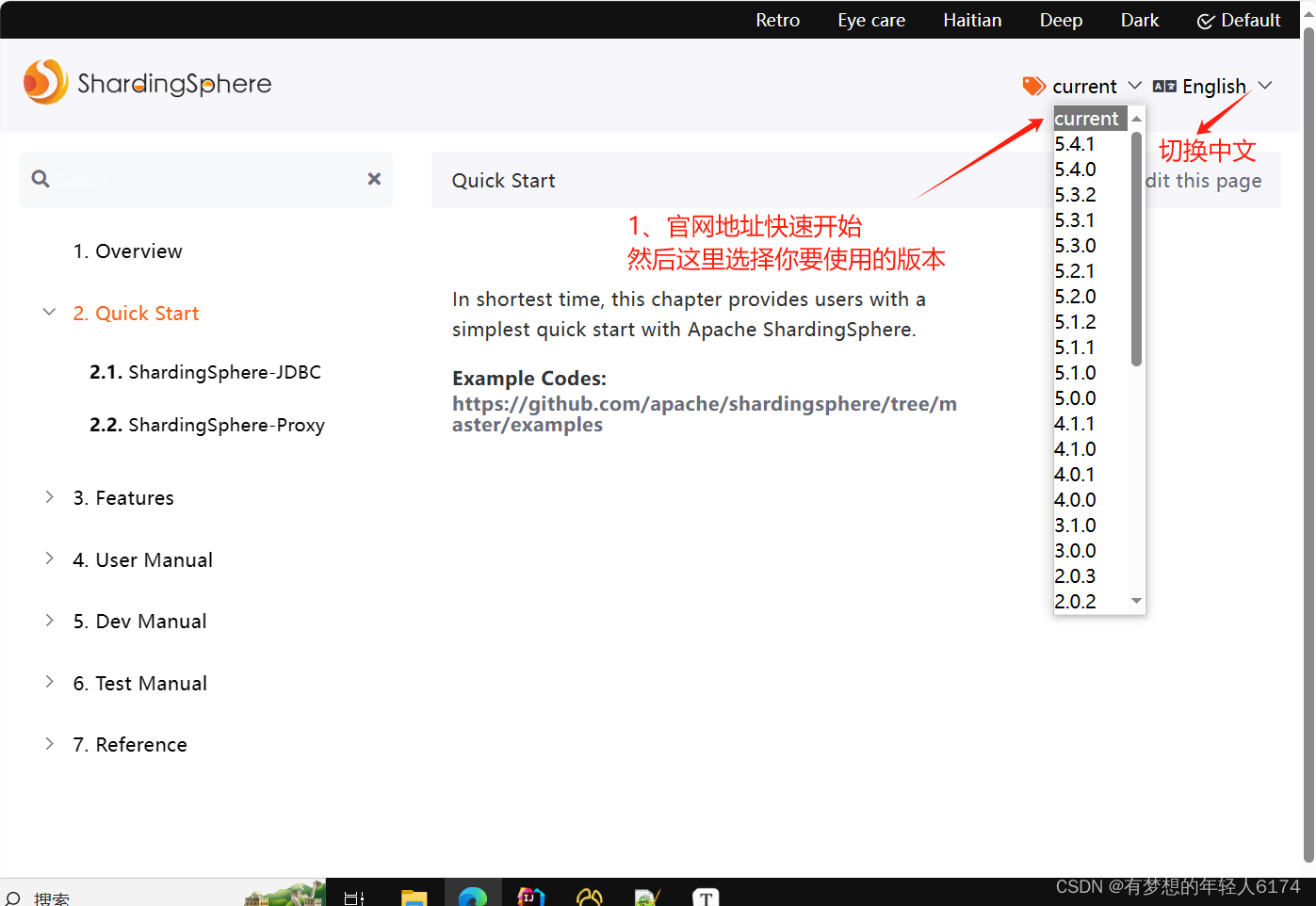引言
开源产品的小故事
Sharding-JDBC是2015年开源的,早期的定位就是一个分布式数据库的中间件,而在它之前有一个MyCat的产品。MyCat也是从阿里开源出来的,作为分库分表的代名词火了很长一段时间,而MyCat早年的目标就是想进入apache(从命名也可以看出,希望像Tomcat一样),但是很可惜最后由于社区运营不是很成熟没有达成。但是现在它的这个愿望早就已经被ShardingSphere达成了,ShardingSphere现在就是apache的顶级开源项目。
ShardingSphere版本演进
从15年开始作为一个小的中间件,发展至今已成为了一个庞然大物。

当不使用分片键时,ShardingSphere是怎么执行的呢?
在之前4.x版本下,这种情况会拆分成多个SQL(每个真实表分片对应一个sql),查询多次。新版本下,会将每一个真实库里的语句通过UNION合并成一个大SQL,一起进行查询。
如果需要对一个真实库进行多个SQL查询,那么就需要通过多线程进行并发查询,这种情况下,如果要进行后续的结果归并,比如sum、max这样的结果归并,那就只能将所有的结果都合并到一个大内存,再进行归并。这种方式称为内存归并。消耗内存,多线程
如果合并成了一个大的SQL,对一个真实库只要进行一次SQL查询,这样就可以通过一个线程进行查询。在进行结果归并时,就可以拿一条数据归并一次。这种方式称为流式归并。极大的节约内存
另外,在使用in进行查询时,有可能计算出属于多个不同的分片。在4.x版本当中,如果出现了这种情况,由于ShardingSphere无法确定in算出来的分片有多少个,所以遇到这种情况,他就不再去计算in中所有的分片结果了,直接改为全路由分片。这样计算比较简单,但是查询的效率肯定不好。而在新版本下,能够准确的计算出分片
补充:ShardingSphere实现分库分表的核心概念
-
虚拟库: ShardingSphere的核心就是提供一个具备分库分表功能的虚拟库,他是一个ShardingSphereDatasource实例。应用程序只需要像操作单数据源一样访问这个ShardingSphereDatasource即可。
-
真实库: 实际保存数据的数据库。这些数据库都被包含在ShardingSphereDatasource实例当中,由ShardingSphere决定未来需要使用哪个真实库。
-
逻辑表: 应用程序直接操作的逻辑表。
-
真实表: 实际保存数据的表。这些真实表与逻辑表表名不需要一致,但是需要有相同的表结构,可以分布在不同的真实库中。应用可以维护一个逻辑表与真实表的对应关系,所有的真实表默认也会映射成为ShardingSphere的虚拟表。
-
分布式主键生成算法: 给逻辑表生成唯一主键。由于逻辑表的数据是分布在多个真实表当中的,所以单表的索引就无法保证逻辑表的ID唯一性。ShardingSphere集成了几种常见的基于单机生成的分布式主键生成器。比如SNOWFLAKE,COSID_SNOWFLAKE雪花算法可以生成单调递增的long类型的数字主键,还有UUID,NANOID可以生成字符串类型的主键。当然,ShardingSphere也支持应用自行扩展主键生成算法。比如基于Redis,Zookeeper等第三方服务,自行生成主键。
-
分片策略: 表示逻辑表要如何分配到真实库和真实表当中,分为分库策略和分表策略两个部分。分片策略由分片键和分片算法组成。分片键是进行数据水平拆分的关键字段。如果没有分片键,ShardingSphere将只能进行全路由,SQL执行的性能会非常差。分片算法则表示根据分片键如何寻找对应的真实库和真实表。简单的分片策略可以使用Groovy表达式直接配置,当然,ShardingSphere也支持自行扩展更为复杂的分片算法。
ShardingSphere-JDBC其他策略
广播表
广播表认为在所有的片里面是一致的,不会进行转发,即使配置了分片规则也不会生效
使用场景:在所有分片都需要的表,比如字典表,在所有库上数据保持一致
参考配置:
# 打印SQL,spring.shardingsphere.props.sql-show,不同版本的参数可能不同,中间是-
spring.shardingsphere.props.sql.show=true
spring.main.allow-bean-definition-overriding=true
spring.shardingsphere.datasource.names=m0,m1spring.shardingsphere.datasource.m0.type=com.alibaba.druid.pool.DruidDataSource
spring.shardingsphere.datasource.m0.driver-class-name=com.mysql.cj.jdbc.Driver
spring.shardingsphere.datasource.m0.url=jdbc:mysql://localhost:3306/coursedb?serverTimezone=UTC
spring.shardingsphere.datasource.m0.username=root
spring.shardingsphere.datasource.m0.password=123666spring.shardingsphere.datasource.m1.type=com.alibaba.druid.pool.DruidDataSource
spring.shardingsphere.datasource.m1.driver-class-name=com.mysql.cj.jdbc.Driver
spring.shardingsphere.datasource.m1.url=jdbc:mysql://localhost:3306/coursedb2?serverTimezone=UTC
spring.shardingsphere.datasource.m1.username=root
spring.shardingsphere.datasource.m1.password=123666spring.shardingsphere.sharding.tables.dict.key-generator.column=dictId
spring.shardingsphere.sharding.tables.dict.key-generator.type=SNOWFLAKE
spring.shardingsphere.sharding.tables.dict.key-generator.props.worker.id=1
spring.shardingsphere.sharding.tables.dict.actual-data-nodes=m$->{0..1}.dict_$->{1..2}spring.shardingsphere.sharding.broadcast-tables=dict测试代码:
@Test
public void dict()
{Dict dict = new Dict();dict.setDictkey("1");dict.setDictval("true");dictMapper.insert(dict);Dict dict2 = new Dict();dict2.setDictkey("2");dict2.setDictval("false");dictMapper.insert(dict2);
}@TableName("dict")
public class Dict {private Long dictid;private String dictkey;private String dictval;@Overridepublic String toString() {return "Dict{" +"dictId=" + dictid +", dictkey='" + dictkey + '\'' +", dictval='" + dictval + '\'' +'}';}public Long getDictid() {return dictid;}public void setDictid(Long dictid) {this.dictid = dictid;}public String getDictkey() {return dictkey;}public void setDictkey(String dictkey) {this.dictkey = dictkey;}public String getDictval() {return dictval;}public void setDictval(String dictval) {this.dictval = dictval;}
}测试结果:两个库的Dict表都增加了两条数据
注意:这里插入的是dict表,而不是dict_1和dict_2
绑定表
参考配置:
spring.shardingsphere.props.sql.show=truespring.shardingsphere.datasource.names=m0,m1spring.shardingsphere.datasource.m0.type=com.alibaba.druid.pool.DruidDataSource
spring.shardingsphere.datasource.m0.driver-class-name=com.mysql.cj.jdbc.Driver
spring.shardingsphere.datasource.m0.url=jdbc:mysql://localhost:3306/coursedb?serverTimezone=UTC
spring.shardingsphere.datasource.m0.username=root
spring.shardingsphere.datasource.m0.password=123666spring.shardingsphere.datasource.m1.type=com.alibaba.druid.pool.DruidDataSource
spring.shardingsphere.datasource.m1.driver-class-name=com.mysql.cj.jdbc.Driver
spring.shardingsphere.datasource.m1.url=jdbc:mysql://localhost:3306/coursedb2?serverTimezone=UTC
spring.shardingsphere.datasource.m1.username=root
spring.shardingsphere.datasource.m1.password=123666#以下是新增部分
spring.shardingsphere.sharding.tables.user.key-generator.column=userid
spring.shardingsphere.sharding.tables.user.key-generator.type=SNOWFLAKE
spring.shardingsphere.sharding.tables.user.key-generator.props.worker.id=1spring.shardingsphere.sharding.tables.user.actual-data-nodes=m$->{0..1}.user_$->{1..2}
spring.shardingsphere.sharding.tables.user_course_info.actual-data-nodes=m$->{0..1}.user_course_info_$->{1..2}spring.shardingsphere.sharding.tables.user.table-strategy.inline.sharding-column=userid
spring.shardingsphere.sharding.tables.user.table-strategy.inline.algorithm-expression=user_$->{Math.abs(userid.hashCode()%4).intdiv(2) +1}spring.shardingsphere.sharding.tables.user_course_info.table-strategy.inline.sharding-column=userid
spring.shardingsphere.sharding.tables.user_course_info.table-strategy.inline.algorithm-expression=user_course_info_$->{Math.abs(userid.hashCode()%4).intdiv(2) +1}spring.shardingsphere.sharding.binding-tables[0]=user,user_course_info绑定表有什么作用呢?
举例生产场景:订单表和订单详情表,这两张表分片键的值是相同的,也就是说在相同分片规则的情况下,关联的数据一定会被分配到同一个分片中,所以直接到指定分片查询就可以了。绑定表在生产上非常常用,当分片数量很多时,比如64分片,试想不使用绑定表的情况下要如何查询(64*64的笛卡尔积,业务上肯定不能接受)
主从模式
早期版本叫主从模式,后续版本叫读写分离,主从做的事情其实就是读写分离。
主从参考配置:
spring.shardingsphere.props.sql.show=truespring.shardingsphere.datasource.names=m0,m1spring.shardingsphere.datasource.m0.type=com.alibaba.druid.pool.DruidDataSource
spring.shardingsphere.datasource.m0.driver-class-name=com.mysql.cj.jdbc.Driver
spring.shardingsphere.datasource.m0.url=jdbc:mysql://localhost:3306/coursedb?serverTimezone=UTC
spring.shardingsphere.datasource.m0.username=root
spring.shardingsphere.datasource.m0.password=123666spring.shardingsphere.datasource.m1.type=com.alibaba.druid.pool.DruidDataSource
spring.shardingsphere.datasource.m1.driver-class-name=com.mysql.cj.jdbc.Driver
spring.shardingsphere.datasource.m1.url=jdbc:mysql://localhost:3306/coursedb2?serverTimezone=UTC
spring.shardingsphere.datasource.m1.username=root
spring.shardingsphere.datasource.m1.password=123666#以下是添加的部分,预期效果对dict表操作,更新到m0库,查询从m1
spring.shardingsphere.sharding.master-slave-rules.gao.master-data-source-name=m0
spring.shardingsphere.sharding.master-slave-rules.gao.slave-data-source-names[0]=m1spring.shardingsphere.sharding.tables.dict.actual-data-nodes=gao.dict
spring.shardingsphere.sharding.tables.dict.key-generator.column=dictid
spring.shardingsphere.sharding.tables.dict.key-generator.type=snowflake
spring.shardingsphere.sharding.tables.dict.key-generator.props.worker.id=1数据加密
对指定的字段类进行加密,加密后的密文字段存在数据表的指定列中。在应用代码使用时仍然操作明文列,但是观察日志可以看出转发到真实表的sql会处理成加密列去做操作,这样就达到了我们想要的效果。
好处是,不需要应用代码中额外的加密操作,内置支持多种加密方式AES、MD5、SM3、RC4等
参跑配置:
spring.shardingsphere.props.sql.show=true
spring.main.allow-bean-definition-overriding=true
spring.shardingsphere.datasource.names=m0,m1spring.shardingsphere.datasource.m0.type=com.alibaba.druid.pool.DruidDataSource
spring.shardingsphere.datasource.m0.driver-class-name=com.mysql.cj.jdbc.Driver
spring.shardingsphere.datasource.m0.url=jdbc:mysql://localhost:3306/coursedb?serverTimezone=UTC
spring.shardingsphere.datasource.m0.username=root
spring.shardingsphere.datasource.m0.password=123666spring.shardingsphere.datasource.m1.type=com.alibaba.druid.pool.DruidDataSource
spring.shardingsphere.datasource.m1.driver-class-name=com.mysql.cj.jdbc.Driver
spring.shardingsphere.datasource.m1.url=jdbc:mysql://localhost:3306/coursedb2?serverTimezone=UTC
spring.shardingsphere.datasource.m1.username=root
spring.shardingsphere.datasource.m1.password=123666spring.shardingsphere.sharding.tables.user.actual-data-nodes=m0.user_$->{1..2}
spring.shardingsphere.sharding.tables.user.key-generator.column=userid
spring.shardingsphere.sharding.tables.user.key-generator.type=SNOWFLAKEspring.shardingsphere.sharding.encrypt-rule.encryptors.encryptor_aes.type=aes
spring.shardingsphere.sharding.encrypt-rule.encryptors.encryptor_aes.props.aes.key.value=123456
spring.shardingsphere.sharding.encrypt-rule.tables.user.columns.password.plainColumn=password
spring.shardingsphere.sharding.encrypt-rule.tables.user.columns.password.cipherColumn=password_cipher
#spring.shardingsphere.sharding.encrypt-rule.tables.user.columns.password.assistedQueryColumn=user_assisted
spring.shardingsphere.sharding.encrypt-rule.tables.user.columns.password.encryptor=encryptor_aes影子库
主要是用在压测的场景,比如说你的业务开发完了,需要测试性能,这个时候最好的情况是压测环境和生产的环境是一样的,影子库就是和生产环境的库是一样的,但是数据不同。在操作生产环境的库时,ShardingSphere内部会转发到影子库去完成测试。但是要注意,既然是压测,对生产环境的性能肯定是有影响的
这里参考配置就不列举了,因为笔者也没测试过,感兴趣的参考官方文档测试效果
总结
学习时建议多关注各种策略的思想(结合虚拟库、真实表等核心概念理解记忆),而且学习ShardingSphere强烈推荐结合官方文档自己多多尝试。使用其实不难的,关键是要找对方法,网上文章千千万,版本也是千奇百怪,初学者看的配置越多可能越不理解,ShardingSphere每个大版本的配置项都有很多改进,所以笔者建议理解每种策略存在的意义,解决问题的思想才是更有价值的。

基本技能:至少要了解每种策略是干什么用的?适合哪些场景?如何参考官方文档配置落地?
高级功能:5.x版本提供的可插拔扩展点使用,比如分片算法策略扩展、路由策略扩展、转发到真实表前的扩展(加密脱敏等)、jdbc数据库扩展、甚至sql的解析规则扩展等(建议学习SPI的扩展方式,源码中大量使用)



: Bidirectional Encoder Representations from Transformers【2】)


)






)





